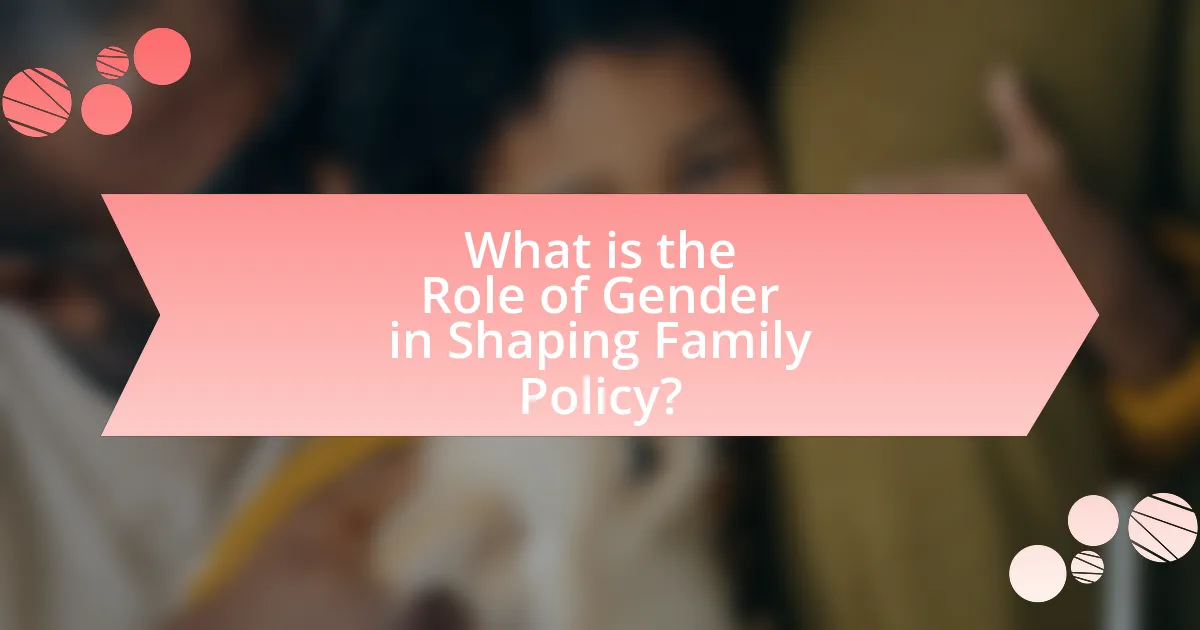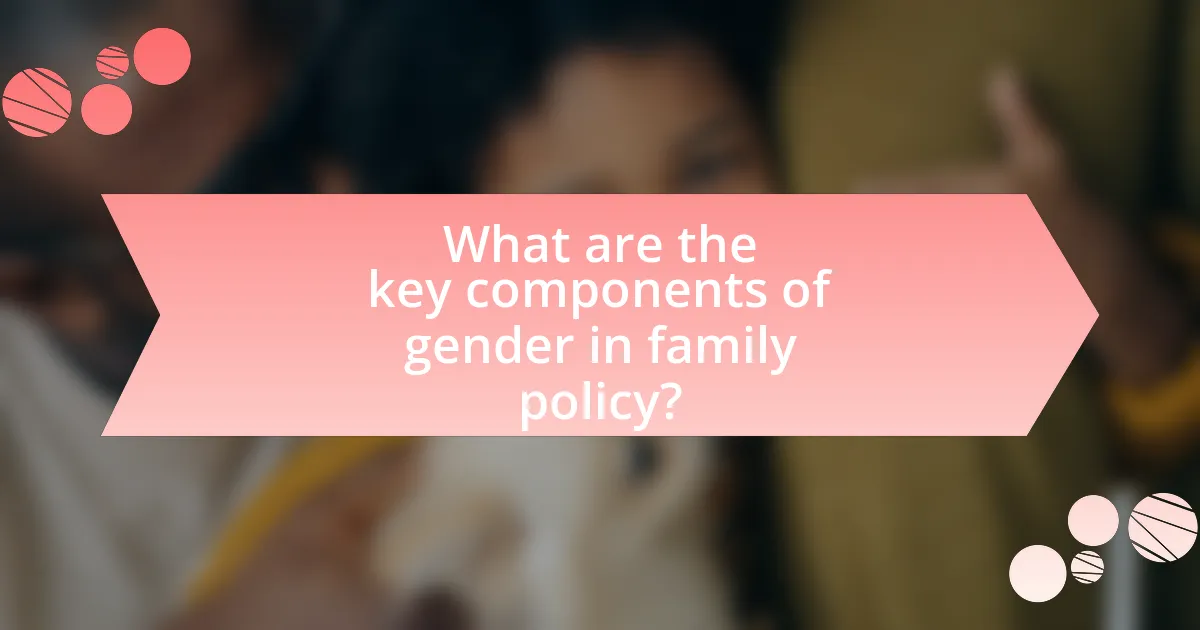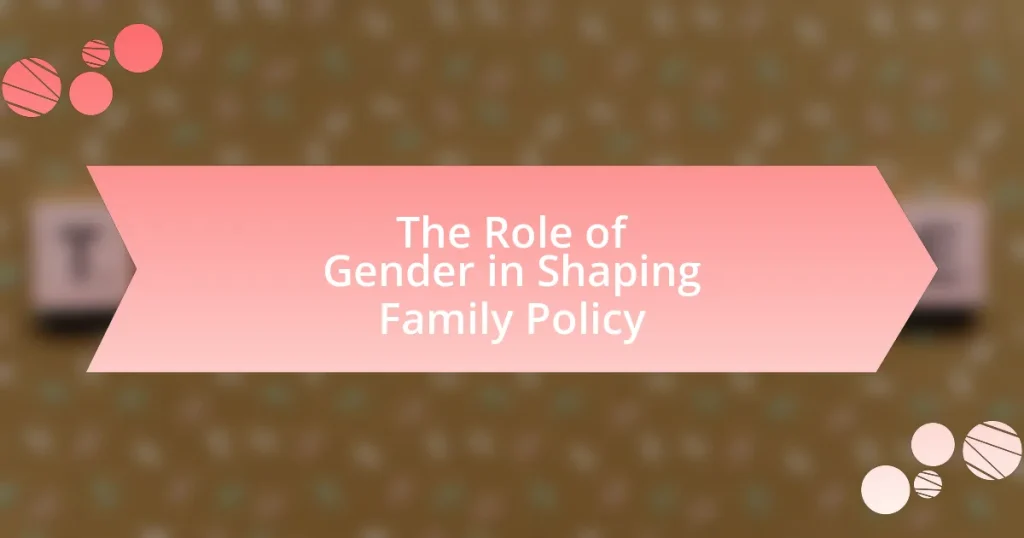The article examines the critical role of gender in shaping family policy, highlighting how gender dynamics influence policy priorities, values, and frameworks. It discusses the impact of gender-sensitive policies on family structures, labor force participation, and child outcomes, using examples from countries like Sweden. The article also explores historical perspectives, cultural attitudes, and the implications of gender biases in policy formulation, emphasizing the importance of gender equality for effective family policies. Key components such as caregiving responsibilities, access to resources, and the roles of diverse gender identities are analyzed to illustrate how inclusive approaches can enhance family policy outcomes.

What is the Role of Gender in Shaping Family Policy?
Gender plays a crucial role in shaping family policy by influencing the priorities, values, and frameworks that guide policy development. Policymakers often consider gender dynamics to address issues such as parental leave, childcare support, and domestic responsibilities, which directly affect family structures and well-being. For instance, research indicates that countries with gender-sensitive policies, like Sweden, have higher rates of female labor force participation and better child outcomes, demonstrating the impact of gender on effective family policy.
How does gender influence family policy decisions?
Gender significantly influences family policy decisions by shaping the priorities and perspectives of policymakers. For instance, research indicates that female policymakers are more likely to advocate for policies that support parental leave, childcare, and family welfare, reflecting a greater emphasis on caregiving roles traditionally associated with women. A study by the Inter-Parliamentary Union found that countries with higher percentages of women in parliament tend to implement more progressive family policies, such as paid parental leave and subsidized childcare, which directly impact family dynamics and economic stability. This correlation underscores how gender representation in political decision-making can lead to more inclusive and supportive family policies.
What historical perspectives shape current gender roles in family policy?
Historical perspectives that shape current gender roles in family policy include the evolution of women’s rights, the impact of industrialization, and the influence of feminist movements. The suffrage movement in the early 20th century established women’s participation in public life, leading to policies that recognized women’s roles beyond the domestic sphere. Industrialization shifted family structures, as economic necessity required women to enter the workforce, challenging traditional gender roles. Additionally, the second-wave feminist movement in the 1960s and 1970s advocated for gender equality, influencing policies related to childcare, parental leave, and workplace rights. These historical developments collectively inform contemporary family policies that aim to balance work and family responsibilities, reflecting an ongoing negotiation of gender roles within society.
How do cultural attitudes towards gender affect family policy formulation?
Cultural attitudes towards gender significantly influence family policy formulation by shaping societal norms and expectations regarding gender roles. For instance, in societies where traditional gender roles are prevalent, policies may prioritize male breadwinners and female caregivers, leading to limited support for working mothers or single-parent families. Research by the OECD indicates that countries with progressive gender attitudes, such as Sweden, implement family policies that promote parental leave for both mothers and fathers, thereby encouraging shared responsibilities and gender equality in caregiving. This demonstrates that cultural perceptions directly impact the design and effectiveness of family policies, as they reflect the values and priorities of the society in which they are created.
Why is understanding gender important in family policy?
Understanding gender is crucial in family policy because it directly influences the dynamics of family structures, roles, and responsibilities. Gender shapes how resources are allocated within families, affects caregiving roles, and impacts access to services and support systems. For instance, research indicates that policies addressing parental leave and childcare significantly benefit families when they consider gender differences in caregiving responsibilities, as women often take on a larger share of unpaid care work. By recognizing these gendered patterns, policymakers can create more equitable and effective family policies that support all family members, ultimately leading to improved social outcomes.
What are the implications of gender biases in family policy?
Gender biases in family policy lead to unequal treatment and resource allocation between genders, adversely affecting women’s economic security and social status. For instance, policies that prioritize traditional family structures often reinforce gender roles, limiting women’s access to employment opportunities and childcare support. Research by the OECD indicates that countries with gender-sensitive family policies, such as paid parental leave and affordable childcare, see higher female labor force participation rates, which contributes to economic growth. Conversely, gender biases can perpetuate cycles of poverty and dependency, as seen in regions where women are primarily viewed as caregivers without adequate support systems.
How does gender equality impact family policy effectiveness?
Gender equality significantly enhances family policy effectiveness by ensuring that policies address the diverse needs of all family members, regardless of gender. When gender equality is prioritized, family policies are more likely to promote shared responsibilities in caregiving and household duties, leading to better outcomes for children and families. Research indicates that countries with higher gender equality, such as the Nordic nations, have implemented family policies that support parental leave for both mothers and fathers, resulting in increased parental involvement and improved child development metrics. This correlation demonstrates that gender equality not only fosters equitable policy frameworks but also leads to more effective family policies that benefit society as a whole.

What are the key components of gender in family policy?
The key components of gender in family policy include gender equality, caregiving responsibilities, and access to resources. Gender equality ensures that both men and women have equal rights and opportunities within family structures and policies. Caregiving responsibilities address the division of labor in households, recognizing the need for policies that support both parents in childcare and domestic duties. Access to resources encompasses economic support, healthcare, and education, which are essential for both genders to thrive within family units. These components are critical for creating inclusive family policies that promote fairness and equity.
How do different gender roles manifest in family policy?
Different gender roles manifest in family policy through the allocation of responsibilities and resources that reflect societal expectations of men and women. For instance, policies often reinforce traditional roles by promoting maternal leave and caregiving support primarily for women, while paternity leave remains less emphasized, reflecting the expectation that women are the primary caregivers. Research indicates that countries with more equitable parental leave policies, such as Sweden, show a more balanced distribution of childcare responsibilities between genders, leading to greater gender equality in both family and workplace settings. This demonstrates how family policy can either perpetuate or challenge existing gender norms, influencing the dynamics of caregiving and labor participation among men and women.
What are the roles of men and women in family policy frameworks?
Men and women play distinct yet complementary roles in family policy frameworks. Men are often seen as primary breadwinners and decision-makers, influencing economic policies that affect family support systems. Women, conversely, are frequently viewed as caregivers, shaping policies related to childcare, parental leave, and family welfare.
Research indicates that inclusive family policies that recognize both roles lead to better outcomes for families. For instance, the OECD reports that countries with gender-sensitive family policies, such as shared parental leave, see increased participation of women in the workforce and improved child development outcomes. This evidence underscores the importance of integrating both men’s and women’s perspectives in the formulation of effective family policies.
How do non-binary and perspectives influence family policy?
Non-binary and perspectives significantly influence family policy by advocating for inclusive definitions of family that recognize diverse family structures beyond traditional norms. These perspectives challenge existing policies that often prioritize heterosexual, cisgender family models, thereby promoting legal recognition and protections for same-sex couples, single-parent families, and non-binary individuals. For instance, research from the Williams Institute indicates that inclusive family policies can lead to better mental health outcomes for individuals and their families, highlighting the importance of representation in policy-making. Additionally, the incorporation of non-binary perspectives into family policy discussions fosters a broader understanding of gender identity, which can lead to more equitable access to resources such as healthcare, adoption, and parental rights.
What types of family policies are affected by gender considerations?
Family policies affected by gender considerations include parental leave, childcare support, and domestic violence protections. Parental leave policies often reflect gender norms, with many countries offering longer leave for mothers than fathers, which can reinforce traditional gender roles. Childcare support policies are also influenced by gender, as they often aim to assist working mothers, thereby acknowledging the disproportionate caregiving responsibilities women typically bear. Additionally, domestic violence protections are shaped by gender considerations, as they address the higher rates of violence experienced by women, leading to specific legal frameworks and support services designed to protect them. These policies illustrate how gender considerations directly impact the formulation and implementation of family policies.
How do parental leave policies reflect gender roles?
Parental leave policies reflect gender roles by often reinforcing traditional expectations of caregiving and employment. In many countries, these policies are designed with the assumption that mothers will take the majority of leave, which perpetuates the stereotype that women are primarily responsible for child-rearing. For instance, in the United States, the Family and Medical Leave Act allows for 12 weeks of unpaid leave, but it does not mandate paid leave, leading to a situation where many fathers feel discouraged from taking leave due to financial constraints. Research shows that in countries with more equitable parental leave policies, such as Sweden, where both parents are incentivized to share leave, there is a notable increase in fathers taking time off, which helps to challenge traditional gender roles. This evidence indicates that parental leave policies can either reinforce or help to reshape societal expectations regarding gender and caregiving responsibilities.
What is the impact of childcare policies on gender equality?
Childcare policies significantly enhance gender equality by enabling both parents to participate equally in the workforce and caregiving responsibilities. Research indicates that countries with comprehensive childcare support, such as Sweden and Denmark, show higher female labor force participation rates, which is approximately 80% compared to 60% in countries with limited childcare provisions. Furthermore, these policies reduce the burden of unpaid care work traditionally shouldered by women, allowing for more equitable distribution of domestic responsibilities. This shift not only promotes economic independence for women but also challenges societal norms regarding gender roles, fostering a more balanced approach to family and work life.

How can gender-sensitive approaches improve family policy?
Gender-sensitive approaches can improve family policy by ensuring that the needs and perspectives of all genders are considered in policy development and implementation. This inclusivity leads to more equitable resource distribution, better support for diverse family structures, and enhanced outcomes for children and caregivers. Research indicates that countries adopting gender-sensitive policies, such as Sweden and Norway, have seen significant improvements in gender equality, parental leave uptake, and child welfare, demonstrating the effectiveness of these approaches in creating supportive family environments.
What strategies can be employed to incorporate gender perspectives in family policy?
To incorporate gender perspectives in family policy, strategies such as conducting gender impact assessments, promoting inclusive stakeholder engagement, and ensuring equitable resource allocation can be employed. Gender impact assessments evaluate how policies affect different genders, ensuring that the unique needs of all family members are considered. Inclusive stakeholder engagement involves consulting diverse groups, including women, men, and non-binary individuals, to gather a wide range of perspectives. Equitable resource allocation ensures that financial and social resources are distributed in a way that addresses gender disparities, promoting fairness and equality in family support systems. These strategies are supported by evidence indicating that policies designed with gender perspectives lead to improved outcomes for families, as seen in various studies highlighting the benefits of gender-responsive policy frameworks.
How can stakeholder engagement enhance gender-sensitive family policies?
Stakeholder engagement can enhance gender-sensitive family policies by incorporating diverse perspectives that reflect the needs and experiences of various gender identities. Engaging stakeholders such as community organizations, advocacy groups, and affected families ensures that policies are informed by real-life challenges and solutions, leading to more effective and inclusive outcomes. For instance, research by the United Nations Development Programme highlights that participatory approaches in policy-making can lead to better alignment with gender equality goals, as they allow for the identification of specific barriers faced by different genders. This collaborative process not only fosters accountability but also promotes the development of tailored interventions that address the unique needs of families, ultimately resulting in more equitable family policies.
What role does data collection play in shaping gender-responsive family policies?
Data collection is essential in shaping gender-responsive family policies as it provides the empirical evidence needed to identify disparities and inform policy decisions. By systematically gathering data on gender-specific issues such as employment, caregiving responsibilities, and access to resources, policymakers can better understand the unique challenges faced by different genders. For instance, the World Economic Forum’s Global Gender Gap Report highlights that countries with comprehensive gender data collection mechanisms are more likely to implement effective policies that address gender inequalities. This data-driven approach ensures that family policies are tailored to meet the specific needs of all genders, ultimately promoting equity and social justice.
What best practices can be adopted for gender-inclusive family policy?
Best practices for gender-inclusive family policy include implementing policies that promote equal parental leave for both mothers and fathers, ensuring access to affordable childcare, and providing flexible work arrangements. Equal parental leave encourages shared responsibilities in child-rearing, which has been shown to improve family dynamics and gender equality in the workplace. Access to affordable childcare allows both parents to participate in the workforce, thereby supporting economic stability and gender equity. Flexible work arrangements, such as remote work options and adjustable hours, enable parents to balance work and family commitments effectively. These practices are supported by research indicating that countries with gender-inclusive policies experience higher rates of workforce participation among women and improved child development outcomes.
How can policymakers ensure equitable representation in family policy discussions?
Policymakers can ensure equitable representation in family policy discussions by actively including diverse voices from various demographic backgrounds, particularly marginalized groups. This can be achieved through targeted outreach efforts, such as community forums and stakeholder consultations, which gather input from women, single parents, families, and low-income households. Research indicates that inclusive policymaking leads to more comprehensive and effective family policies, as evidenced by studies showing that diverse representation results in policies that better address the needs of all family structures. For instance, the 2019 report by the Institute for Women’s Policy Research highlights that policies developed with input from diverse groups are more likely to consider the unique challenges faced by different family types, thereby promoting equity in family policy outcomes.
What are the key indicators of successful gender integration in family policy?
Key indicators of successful gender integration in family policy include equitable access to resources, representation of diverse gender perspectives in policy-making, and measurable improvements in gender equality outcomes. Equitable access to resources ensures that both men and women benefit equally from family policies, such as parental leave and childcare support. Representation of diverse gender perspectives in policy-making involves including voices from various gender identities to create inclusive policies. Measurable improvements in gender equality outcomes can be assessed through statistics on employment rates, wage gaps, and the distribution of unpaid care work, which reflect the effectiveness of gender integration in family policy.
